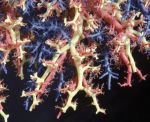EPJ E Highlight - Understanding the evolution of lungs through physical principles
- Details
- Published on 01 October 2013

How fluid dynamics and transport shaped the structure of our lungs in the course of evolution.
Two French physicists, Bernard Sapoval and Marcel Filoche from École Polytechnique in Palaiseau, France, suggest in a study published in EPJ E how evolution has shaped our lungs through successive optimisations of physical parameters such as conservation of energy and speed of delivery.
Our respiratory system consists of a bronchial tree designed to transport air through the lungs combined with an alveolar system designed to capture the oxygen. Both are subjected to different type of optimisations. Only tree-like structures, the paper shows, are able to efficiently feed organs above a small size, below which organs are solely fed by diffusion. Specifically, the authors first show that energy losses of fluids during transport are minimised in a tree-like structure of fractal dimension 3. Second, they indicate that this optimised tree is also ‘space-filling’ to optimise proximity to the working alveolae. Third, they show that a system designed to reduce the time spent to transport fluids throughout an organ has the same fractal optimisation.
In an evolutionary perspective, the size of primitive multi-cellular species was necessarily limited by nutrients’ diffusion speed. One hypothesis defended in this study is that larger primitive animals have thus been conditioned by a progressive Darwinian selection of tree-like ‘space-filling’ nutrient distribution systems. Then, their genetic material was ready to be shared to allow mammalian respiration. Successive inspirations and expirations cycles had to be optimised so that external air could reach the alveoli before expiration starts. This form of evolutionary tinkering, the authors believe, would have allowed the emergence of mammalian respiration—as opposed to fish-style breathing through gills.
Similarly, the paper shows that the structure of the alveolar system is indeed optimal to allow efficient transport of oxygen from the air to the blood. This new insight into the lung’s evolutionary process stems from the physical principles underlying the architecture of living systems.
Optimisations and evolution of mammalian respiratory systems. B. Sapoval and M. Filoche (2013), European Physical Journal E 36: 105, DOI 10.1140/epje/i2013-13105-1




